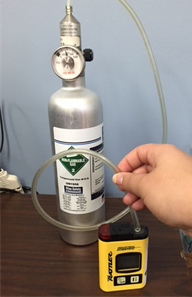Evaluation of Low-Cost Hydrogen Sulfide Monitors for Use in Livestock Production
Jessica Beswick-Honn, Thomas M. Peters, T. Renée Anthony
Journal of Agricultural Safety and Health 23(4): 265-279 (2017)
ABSTRACT:
Direct-reading gas monitors warn workers of the risk of potentially fatal hydrogen sulfide (H2S) exposures that may arise during manure handling. Low-cost, low-maintenance H2S monitors are available from many manufacturers, but differences in their features and performance make selection challenging for farmers. Moreover, little information is available on the practical maintenance and performance of these devices in agricultural environments. The objective of this study was to provide information to agricultural workers to aid in the selection, maintenance, and use of low-cost H2S monitors. This laboratory study evaluated the performance of several low-cost monitors over a simulated period of use of one year in a swine barn. Four models were exposed to H2S concentrations of 1 to 10 ppm over 18 weeks to examine the drift in reported concentration and changes in the alarm reaction time. Over the simulated barn year, the performance of alarm-only monitors declined faster than that of monitors displaying the H2S concentration. Of concern was the high-level (20 ppm) alarm failures after an equivalent of 139 days (Altair) and 289 days (BW Clip) in a swine barn, well within the monitor’s reported shelf-life. Models displaying concentration exhibited fewer failures but were inaccurate in the displayed concentration when challenged with 20 ppm of H2S. The T40 Rattler provided consistently higher readings (+2.3 ppm), and the Pac 3500 showed consistently lower readings (-3.4 ppm) when challenged with 20 ppm. This study confirms the need for routine bump tests for these low-cost monitors to ensure that the monitor reacts to the presence of H2S, even if the manufacturer does not recommend this procedure. Most importantly, agricultural workers should inspect and bump test these monitors prior to any potentially high-risk activity, such as manure agitation, pumping, or pressure washing, to ensure that the monitor appropriately detects and warns users.
Performance Summary: Number of days until a monitor exhibited its first "failure", with days representing time stored in a livestock building

Demonstration of bump testing procedure, using T40 Rattler hydrogen sulfide monitor

Article: ![]() jash-2017_23_4_evalulation_h2s_monitors-final.pdf
jash-2017_23_4_evalulation_h2s_monitors-final.pdf
Press Release: ![]() h2s_gas_monitors_press_release_11_20_17.docx
h2s_gas_monitors_press_release_11_20_17.docx